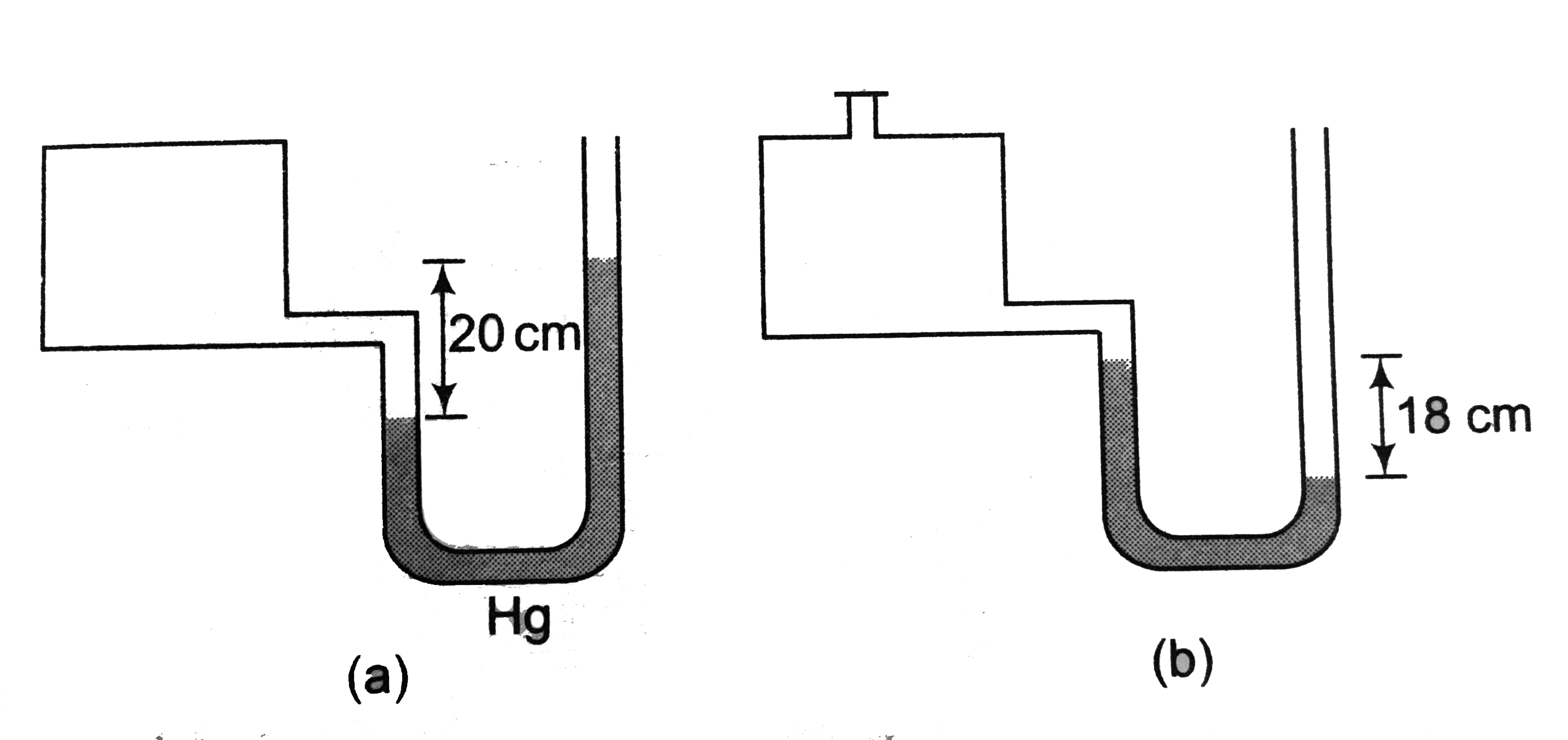NCERT (Additional Exercises) from MODERN PUBLISHERS PHYSICS Chapter 22 MECHANICAL PROPERTIES OF FLUIDS for Class 11
| Class 11 | PHYSICS |
| Chapter | MECHANICAL PROPERTIES OF FLUIDS |
| MODERN PUBLISHERS PHYSICS | NCERT (Additional Exercises) |
| Medium | English |
| Academic Year | 2023-2024 |
Question 1
A tank with a square base of area 1.0m2 is divided by a vertical parition in the middle. The bottom of the partition has a small hinged door of area 20cm2. The tank is filled with water and an acid (of relative density 1.7) in the other, both to a height of 4.0m. Compute to force necessary the force nec cessary to keep the door closed.View SolutionQuestion 2
A manometer reads the pressure of a gas in a enclosure as shown in figure(a) When some of the gas is removed by a pump, the manometer reads as in (b). The liquid used in the manometers is mercury and the atmospheric pressure is 76cm of mercury.

(i) Give the absolute and gauge pressure of the gas in the enclosure for cases (a) and (b) in units of cm of mercury .
(ii) How would the level change in case (b) if 13.6cm of water are poured into the right limb of the manometer?View SolutionQuestion 3
Two vessels have the same base area but differnent shapes. The first vessel takes twice the vloume of water that the second vessel requires to fill up to a paricular common height . Is the force exerted by water on the base of the vessel the same in the two case? If so, why do the vessels filled with water to that same height give different reading on a weighting scale ?View SolutionQuestion 5
In deriving Bernoulli's equation , we equated the workdone on the fluid in the tube to its change in the potential and kinetic energy (a) How does the pressure change as the fluid moves along the tube if dissipative forces are present ? (b) Do the dissipative forces becomes more important as the fluid velocity increase? Discuss qualitatively. View SolutionQuestion 8
In Millikan's oil drop experiment, what is the terminal speed of a speed of a drop of radius 2.0×105m and density 1.2×103m−3? Take the viscosity of air at the temperature of the experimental to be 1.8×10−5Nsm2. How much is the viscous force on the drop at that speed? Neglect buoyancy of the drop due to air. View SolutionQuestion 9
Mercury has an angle of contact equal to 140∘ with soda lime galss. A narrow tube of radius 1.00mm made of this glass is dipped in a through containing mercury. By what amount does the mercury dip down in the tube relative to the mercury surface outside? Surface tension of mercury at the temperature of the experiment is 0.465Nm−1. Density of mercury = 13.6×103kgm−3.View SolutionQuestion 10
Two narrow bores of diameters 3.0mm and 6.0 mm are joined together to form a U-shaped tube open at both ends. If th U-tube contains water, what is the difference in its levels in the two limbs of the tube? Surface tension of water at the temperature of the experiment is 7.3×10−2Nm−1. Take the angle of contact to be zero. and density of water to be 1.0×103kg/m3.
(g=9.8ms−2)View SolutionQuestion 11
(a). It is known that density ρ of air decreases with height y as
ρ=ρ0e−y/y(_o) ltb rgt where po=1.25kgm−3 is the density at sea level, and yo is a constant. This density variation is called the law of atmospheres. Obtain this law assuming that the temperature of atmosphere remains a constant (isothermal conditions). Also assume that the value of g remains constant
(b). A large He balloon of volume 1425m3 is used to lift a payload of 400 kg. Assume that the balloon maintains constant radius as it rises. How high does it rise?
[take yo=8000mandρHe=0.18kgm−3]View Solution
All Exercises from MODERN PUBLISHERS PHYSICS Class 11 PHYSICS MECHANICAL PROPERTIES OF FLUIDS
- Chapter Practise Test
- Competition File (A. MCQ (Objectie Type Questions))
- Competition File (Assertion Reason Type Questions)
- Competition File (B. MCQ (AIPMT/NEET & Other State Boards For Medical Entrance))
- Competition File (C. MCQ With More Than One Correct Answers)
- Competition File (D. MCQ Based On A Given Passage/Comprehension)
- Competition File (Integers Type Questions)
- Competition File (JEE (Advanced) For IIT Entrance)
- Competition File (JEE (Main) & Other State Boards For Engineering Entrance)
- Conceptual Questions
- HOTS (Higher Order Thinking Skills) (Advanced Level))
- NCERT (Additional Exercises)
- NCERT (Exemplar Problems (Subjective Questions))
- NCERT (Short Answer Type Questions)
- NCERT (Textbook Exercises)
- NCERT File (Exemplar Problems (Objective Questions))
- NCERT File (MCQ)
- Practice Problems
- Problems
- Revision Exercise (Additional Questions)
- Revision Exercise (Fill in the Blanks)
- Revision Exercise (Long Answer Questions)
- Revision Exercise (Numerical Problems)
- Revision Exercise (Short Answer Questions)
- Revision Exercise (Very Short Answer Questions)
- Solved Examples